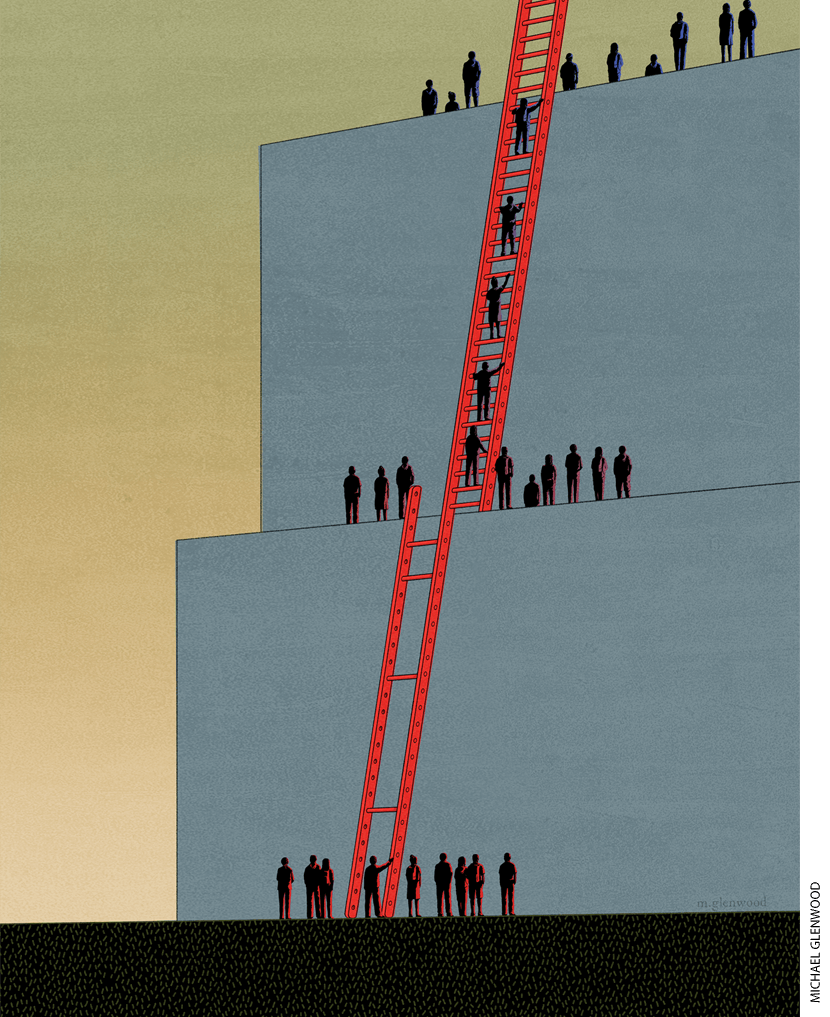
How can we improve academic achievement and college attainment for disadvantaged students? To address this question, education researchers typically assess the impact of various interventions on all students whose family income falls under the limit for free or reduced-price school lunch—a broad category that fails to account for the effects of ethnicity and class in combination, as well as the considerable differences in economic and cultural resources among lower-income families in the United States.
This includes an earlier study co-authored by one of us, which used a randomized control trial to evaluate a school-voucher intervention in New York City and found modest positive impacts on college enrollment of African American and Hispanic American students (see “The Impact of School Vouchers on College Enrollment,” research, Spring 2013). That study, like many others, did not explore whether the program’s effects differed based on varying levels of disadvantage. We return here to the New York City voucher program to do just that.
Our study looks at the impact of using a voucher on college enrollments and on degree attainment. We also estimate effects of just being offered a voucher, even if it is not used to enroll in a private school. Our data now cover a span of 21 years, which allows us to record college enrollment and attainment up to seven years after a student’s anticipated date of high-school graduation and observe students’ college-going behavior even if their education was interrupted.
We find large differences in impacts between moderately and severely disadvantaged students. An offer of a voucher has no detectable benefit for severely disadvantaged students—minority students from either extremely low-income households or whose mothers did not enroll in college. However, for minority students who are either from a moderately low-income household or whose mother has attended college, being offered a voucher increases college-enrollment rates by about 15 percent and four-year degree attainment by about 50 percent. Those impacts are even larger if students actually use the voucher to enroll in a private school: enrollment at any college increases by up to 30 percent and four-year degree attainment increases by nearly 70 percent.
The voucher intervention we study did have its intended effects—but only for students from disadvantaged families that nonetheless had a certain amount of material and cultural capital. Our findings point to the limitations of half-tuition vouchers to promote college enrollment and graduation among the least-advantaged students, as well as their potential value for those with access to greater fiscal and cultural resources.
Unpacking “Disadvantage”
Evaluations of education interventions seldom account for differences among students in terms of their relative disadvantage. But other branches of research have drawn more nuanced distinctions.
For example, a number of sociologists and anthropologists have drawn contrasts between moderately disadvantaged and more severely deprived groups. In a classic study, William Julius Wilson emphasized the “social isolation” of deeply impoverished, racially segregated neighborhoods, where quality schools, suitable marriage partners, and “exposure to informal mainstream social networks and conventional role models” are in short supply. He theorized that programs designed to promote equality of opportunity that have positive impacts on the moderately disadvantaged may have little or no impact on “the truly disadvantaged.”
Consistent with this theory, quantitative research has documented sizeable differentials in educational attainment between those who are moderately and severely disadvantaged. For example, Martha Bailey and Susan Dynarski find important differences in the college-enrollment practices of students from the poorest families and those who are less so. Only 29 percent of high-school students born between 1979 and 1982 who lived in households in the lowest quartile of the distribution enrolled in college. But for students in the second-lowest quartile, the rate of college enrollment was 47 percent. The difference was starker still in those students’ college graduation rates: 9 percent among those in the lowest quartile versus 21 percent among those in the second quartile.
Meanwhile, qualitative research has deepened our understanding of the cultural and material challenges of those who are truly disadvantaged by both ethnic and class isolation. In his influential 1969 book examining an inner-city neighborhood in Washington, D.C., ethnographer Ulf Hannerz distinguishes between residents he labels “mainstreamers” and “street families.” The former, he says, are “stable working-class people” who “conform most closely to mainstream American assumptions about the ‘normal’ life.” By contrast, “street families” experience periodic unemployment and rely on government transfers.
Like Wilson, some sociologists focus on the structural effects of neighborhoods on the educational attainment and social mobility of the two groups. For example, John Kasarda has shown how the lack of private transport in large cities limits the access of the isolated urban poor to employment and other opportunities distant from the immediate neighborhood. But anthropologists note that poor neighborhoods contain diverse populations, and culture is not easily reduced to structural factors. The truly disadvantaged do not need to concentrate in specific places to lack cultural and material resources.
Despite the range of deprivation to be found among those perceived to be disadvantaged, researchers typically use participation in the National School Lunch Program as their poverty indicator, a blunt measure. Students are eligible for free or reduced-price meals at school if their household income is as much as 185 percent of the federal poverty line. In 1997, when the voucher program we study here launched, 37 percent of U.S. students received subsidized lunches. The income limit for free lunch was set at $16,874 for a family of three and $20,280 for a family of four, or $27,518 and $33,072 in 2020 dollars. Since then, Congress has allowed entire school districts to provide free meals to all students without collecting individual income-based applications if at least 40 percent of enrolled students receive other subsidized services, such as food stamps. By 2015, some 52 percent of U.S. students were eligible for free or reduced-price school lunches. When over half the student population are defined as poor, the definition of poverty is a very generous one.
In short, eligibility for participation in the school-lunch program does not provide a precise indicator of the population that Wilson characterized as truly disadvantaged. Yet a good deal of education research uses it as the sole indicator of socioeconomic status.
Revisiting a School-Choice Study
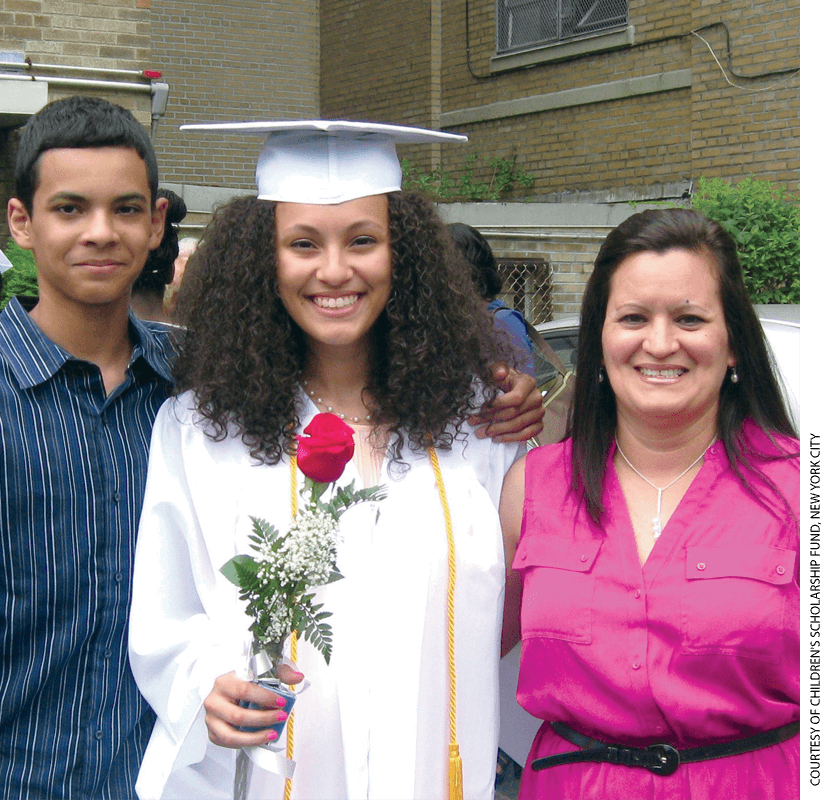
School-choice programs also define the eligible population in fairly broad terms that include not only those who are truly disadvantaged but also those who are only moderately disadvantaged. But to be effective, the exercise of choice would seem to require at least a certain amount of economic and cultural resources. Parents must have the time and energy to select the appropriate setting for their child, and the family may be expected to cover the cost of school uniforms, educational materials, and travel to and from the school. Beyond material considerations, schools may have rules for behavior with which students must comply if they are to remain in the school and demanding expectations for family involvement.
Yet evaluations of school-choice interventions typically ignore important differences in family capacities. Estimates of program impacts are typically made for the entire participating population or for all members of specific ethnic groups. This was the case in the earlier study of the New York City voucher program, to which we now turn.

In 1996, when New York City public schools did not open on time, the archdiocese responsible for the city’s Catholic schools offered to accept the public school’s one thousand “worst” students. The chancellor of the city’s school system rejected the proposal, but Mayor Rudy Giuliani embraced it, setting off a political firestorm over the proper boundaries between church and state. In the midst of this controversy, the nonprofit School Choice Scholarships Foundation was formed to provide private-school scholarships to any participating secular or religious private school in New York City. The foundation announced in February of 1997 that it would provide half-tuition scholarships for at least three years to 1,000 eligible elementary-school students. The scholarships were worth up to $1,400 per child per year and were for students entering grades 1 to 5 who qualified for free or reduced-price school lunch. Some 85 percent of the scholarships were reserved for students attending schools that had average reading and math scores below the citywide median on state tests.
More than 20,000 students applied. A sample of voucher applicants participated in an in-person eligibility screening, during which students took basic-skills tests in reading and math and the accompanying adult completed a questionnaire asking them about the child’s current school and the family’s demographic background. The vouchers were awarded by lottery in May 1997 and recipients entered private schools in the 1997–98 school year. Although the initial voucher offer was limited to three years, the scholarships were later extended to the end of 8th grade for students who had remained continuously in participating private schools.
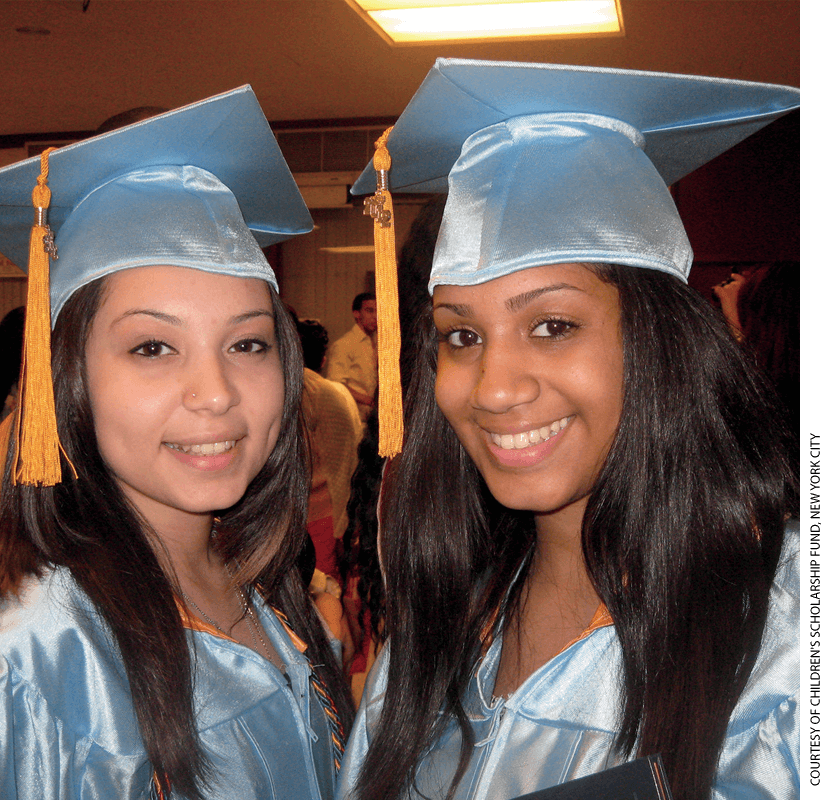
Our analysis includes 2,634 students: a “treatment” group of 1,356 who received an offer of a voucher and a “control” group of 1,278 students who did not. The treatment and control groups have similar overall characteristics. Forty-two percent of the treatment group and 41 percent of the control group are African American, and 42 percent of the treatment group and 47 percent of the control group are Hispanic American. About one third of both groups report having an absent father.
To identify students deprived by both ethnicity and socioeconomic background, we restrict our analysis to students who are identified as a member of a minority group — that is, if the accompanying adult at the information verification session said that the ethnicity of the mother is either African American or Hispanic American. We then distinguish between “moderate” and “severe” disadvantage based on whether a minority student’s mother has any education beyond a high-school diploma. That decision is informed by research about first-generation college students, who are less likely to complete a degree. Among students offered a voucher, about 55 percent are at moderate disadvantage because their mothers have at least some college education; the other 45 percent are at severe disadvantage because their mothers did not go beyond high school, including 17 percent whose mothers dropped out.
We also look across levels of family income among minority students to distinguish between moderate and severe disadvantage. Some 49 percent of students live in households we consider “extremely low income” because they earn less than $13,067 a year (in 2020 dollars). That is half of the poverty line for a family of four and the level the U.S. Department of Agriculture uses to indicate “severe poverty.” We consider the other 51 percent of the treatment group, whose households earn at least $13,068 annually, to be “moderately low income,” including 10 percent whose households earn $32,670 or more.
With data from the National Student Clearinghouse on college outcomes as of 2017, we are able to compare college enrollment and degree attainment between the treatment and control groups after at least seven years of every student’s anticipated high-school graduation date. We are thus able to detect enrollment and degree acquisitions even if progress by students is delayed for an additional four years beyond what was observed in the prior study of this program. During the intervening period, enrollments at four-year institutions in the study sample increased to 29 percent from 26 percent and the four-year graduation rate increased to 16 percent from 10 percent, a 60 percent increase.
Results
Our analysis considers enrollment and degree attainment at both two-year and four-year schools. We look at the impact of the voucher program in two ways: the effect of being offered a voucher, whether or not it was ever used, and the effect of actually using the voucher to attend a private school for some period of time. About 78 percent of students who were offered $1,400 tuition vouchers actually used them for at least some period of time.
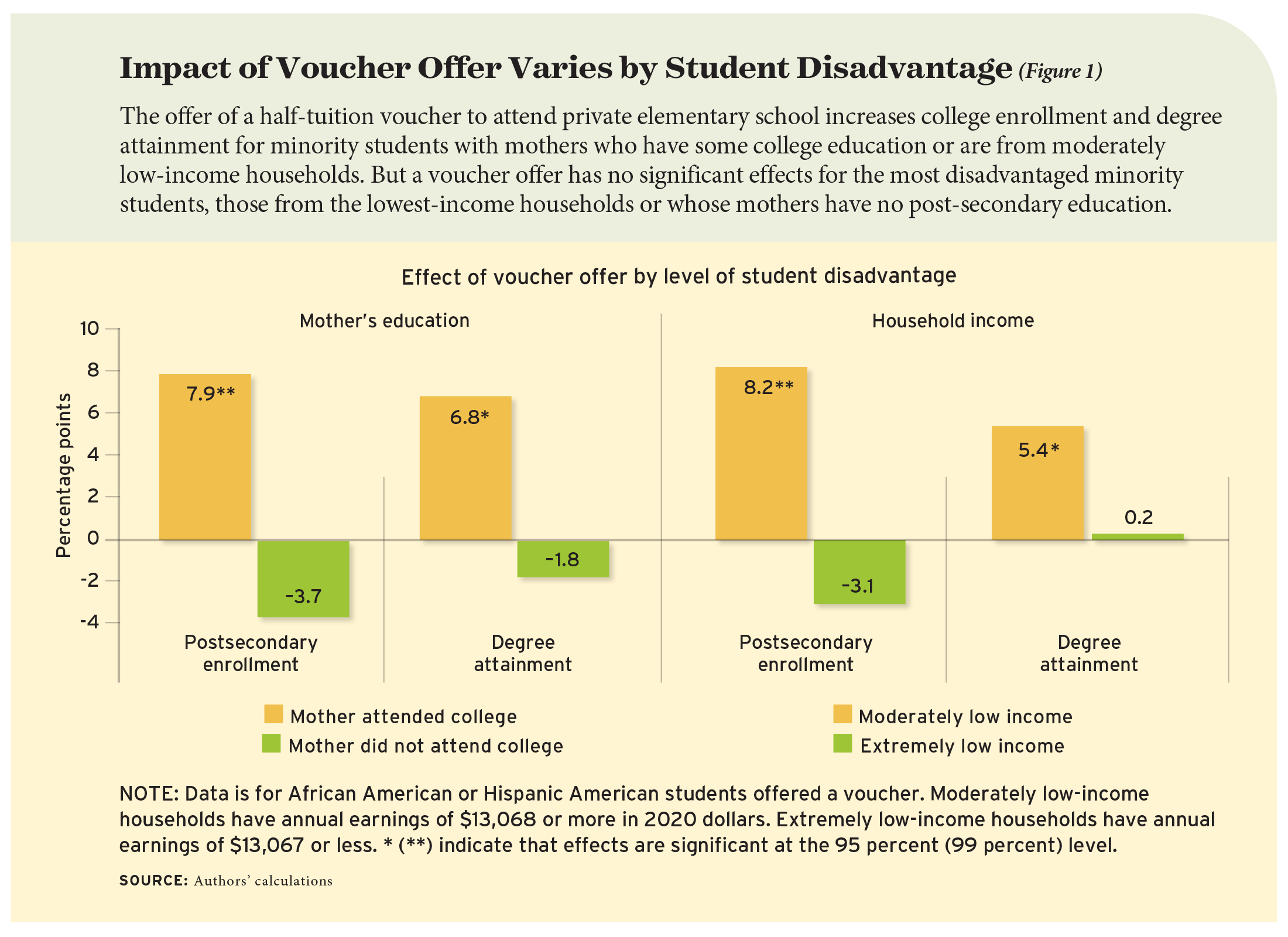
Impacts of a Voucher Offer. In looking at the entire treatment group, the offer of a voucher did not have a significant impact on students enrolling in or graduating from college. However, when looking separately at students who are at moderate or severe disadvantage, we find different impacts depending on student ethnicity, mother’s education, and household income. Minority students whose mothers have some college education are 8 percentage points more likely to enroll in any college if a voucher was offered, but those whose mothers did not progress beyond high school are about 4 percentage points less likely to enroll if offered a voucher (see Figure 1). In looking at degree attainment, we find a difference of 9 percentage points. Minority students with college-educated mothers are 7 percentage points more likely to graduate if offered a voucher—both for any college and four-year colleges. But we find that would-be first-generation minority students, those whose mothers did not attend college, are about 2 percentage points less likely to graduate—an impact that is not significantly different from zero.
We also observe a difference of 11 percentage points in rates of college enrollment among minority students who are at either moderate or severe economic disadvantage. Among minority students from moderately low-income households, the offer of a voucher boosts college enrollment by 8 percentage points and degree attainment by 5 percentage points. But the offer of a voucher does not have a positive impact on minority students from the lowest-income households, who are 3 percentage points less likely to enroll in college and no more likely to earn a degree than those in the control group. The voucher offer seems to have a noticeable impact on college enrollment and degree attainment for students who are only moderately disadvantaged by income, but no significant effect on students with severe income constraints.
For the most part, we do not observe differential effects on enrollment or degree completion at two-year colleges by either mothers’ education or household income. Apparently, the effects of the voucher offer on moderately advantaged students is to increase the overall percentage of college enrollments and to shift college choice from pursuit of a two-year degree to that of a four-year degree.
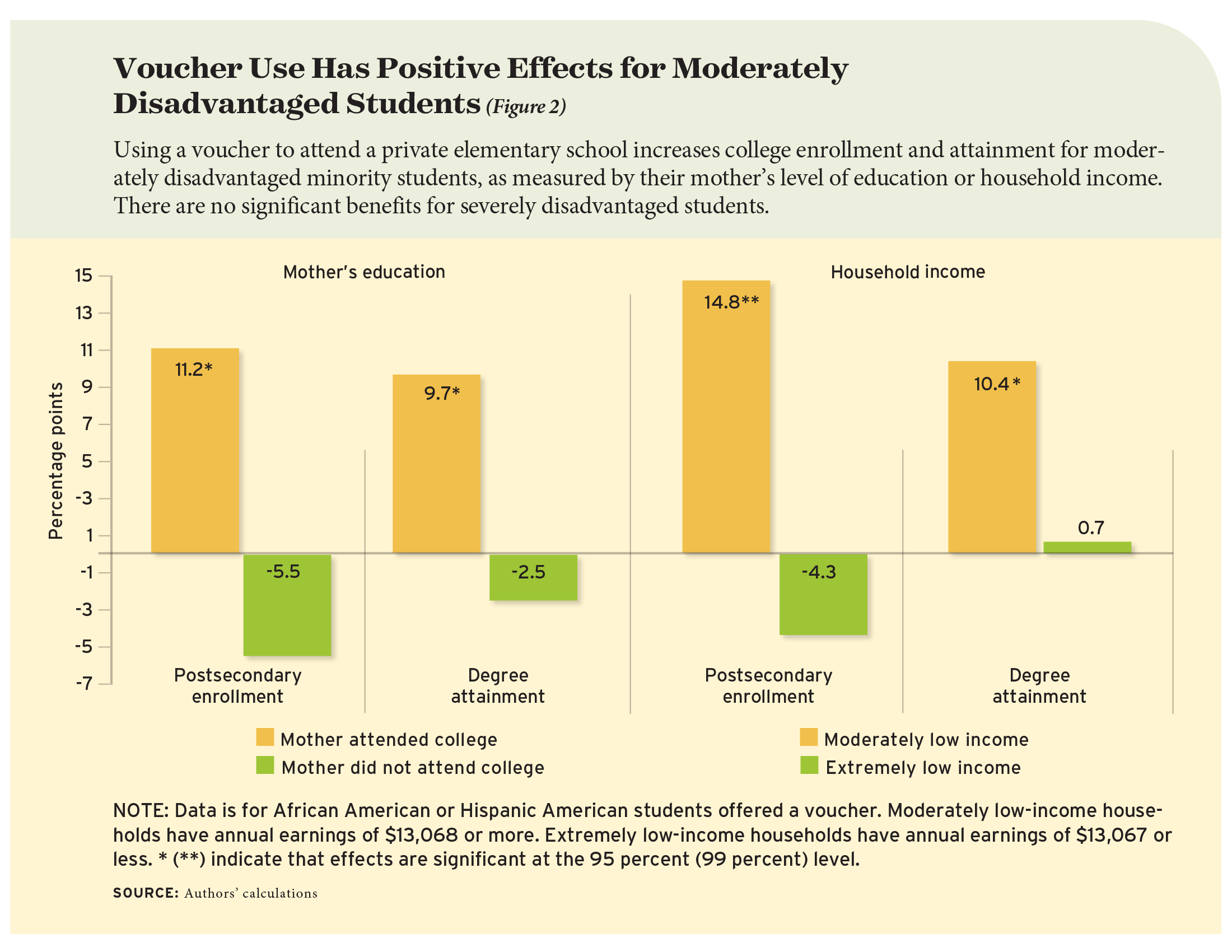
Impacts on Using a Voucher to Attend Private School. Children at moderate disadvantage, based either on their mother’s level of education or household income, are not significantly more likely than their less-advantaged peers to use a voucher to attend private school for at least some period of time. But the effects of the use of that voucher vary considerably by degree of deprivation.
For minority students whose mothers have some college education, using a voucher to attend private school boosts their enrollment rates at any college by 11 percentage points—a 21 percent increase (see Figure 2). For minority students whose households are moderately low-income, voucher use boosts enrollment by 15 percentage points. Moderately disadvantaged minority students who use vouchers also are more likely to earn a college degree. We find an impact of 10 percentage points on degree attainment both for students whose mothers have some college education and for students from moderately low-income households.
We underscore the especially notable impact on moderately disadvantaged students earning four-year degrees. Minority students at moderate disadvantage who use a voucher are 10 percentage points more likely to go on to earn a four-year college degree than those in the control group. Given the relatively low levels of college enrollment and degree attainment by disadvantaged students, this represents an increase of almost 70 percent.
In contrast, voucher use did not have a statistically significant effect on either college enrollment or degree completion for severely disadvantaged students. The difference in the impact of voucher use on minority students whose mothers did and did not attend college is 17 percentage points for enrollment and 12 percentage points for degree completion. The difference in the impact of voucher use on minority students from extremely and moderately low-income families is 19 percentage points for college enrollment and 10 percentage points for degree completion.
Discussion
As with the earlier study, our analysis finds little impact from the offer of a voucher when looking at the entire sample. But with data from four additional years, as well as by looking for differences in effects between moderately and more severely disadvantaged students, we find important differences. The voucher intervention has sizeable, positive impacts for students who, while still disadvantaged by most definitions, have more cultural and financial resources at home. This resembles conclusions drawn by qualitative research, which suggest that students and families often find it difficult to take advantage of school-choice opportunities unless their cultural and material resources have reached a certain minimum.
These results raise policy questions about voucher size. The New York City vouchers covered only half the costs of private-school tuition and were capped at $1,400. That amount seems unlikely to be helpful for the most disadvantaged families, who were unlikely to be able to pay the balance of the bill.
In addition, the significant moderating effects of mothers’ levels of education suggest that cultural factors may be at work. As numerous studies have shown, social and cultural capital are crucial for educational attainment. Nurturing social networks and institutions that enable parents to participate fully in voucher programs may be necessary to reap the benefits they provide. Schools, too, need to tend to the cultural needs of students and families if they wish to serve them effectively. In the presence of gaps in financial and cultural capital, school choice may do little to alleviate inequalities within the low-income community, as the most disadvantaged families remain in less effective educational institutions. This has evoked criticism, such as Diane Ravitch’s assertion that schools of choice “will leave regular public schools with the most difficult students to educate, thus creating a two-tier system of widening inequality.” But other commentators, such as Robert Pondiscio, say there is little reason why “low-income families of color should not have the ability to send their children to school with the children of other parents who are equally engaged, committed or ambitious for their children, [as that] is what affluent parents do.”
Whatever the merits of these alternative judgments, the results reported here suggest that the opportunity to attend a private school does not provide uniform benefits to disadvantaged students. Students whose households are in the most dire economic distress, and those whose mothers did not graduate or progress beyond high school, do not experience the same substantial, positive impacts as their less-disadvantaged peers. The New York City voucher program may have enhanced the educational opportunities for some low-income students, but the tools, policies, and institutions needed to ensure all students, including the “truly disadvantaged,” can realize their academic potential remain elusive.
Albert Cheng is assistant professor in the Department of Education Reform at the University of Arkansas College of Education and Health Professions. Paul E. Peterson, professor of government at Harvard University, directs the Program on Education Policy and Governance and is senior editor of Education Next. This article is adapted from a study published in Sociology of Education.
This article appeared in the Summer 2021 issue of Education Next. Suggested citation format:
Cheng, A. and Peterson, P.E. (2021). School Choice and “The Truly Disadvantaged”: Vouchers boost college going, but not for students in greatest need. Education Next, 21(3), 52-58.


